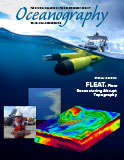Article Abstract
We aim to understand the surface kinetic energy cascade across a wide range of length scales in the western tropical Pacific (WTP) and the influence of both climatic dynamics and topography using a high-resolution (2.5 km) model nested within a coarser (8 km) state-estimate model. The period of interest includes the development and realization of the 2014–2015 El Niño. The energy cascade in the WTP is similar to that of the extratropics, with simultaneous dual inverse and forward cascades of kinetic energy to larger and smaller scales, with the strongest source of energy near the local baroclinic Rossby radius. We find that topography enhances the strength of the mean surface cascades in both forward and inverse directions, altering the energy transfer in the WTP on both long timescales important for determining the mean distribution of kinetic energy across a range of length scales and short timescales relevant for dynamical prediction.

